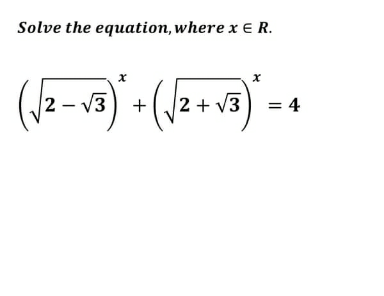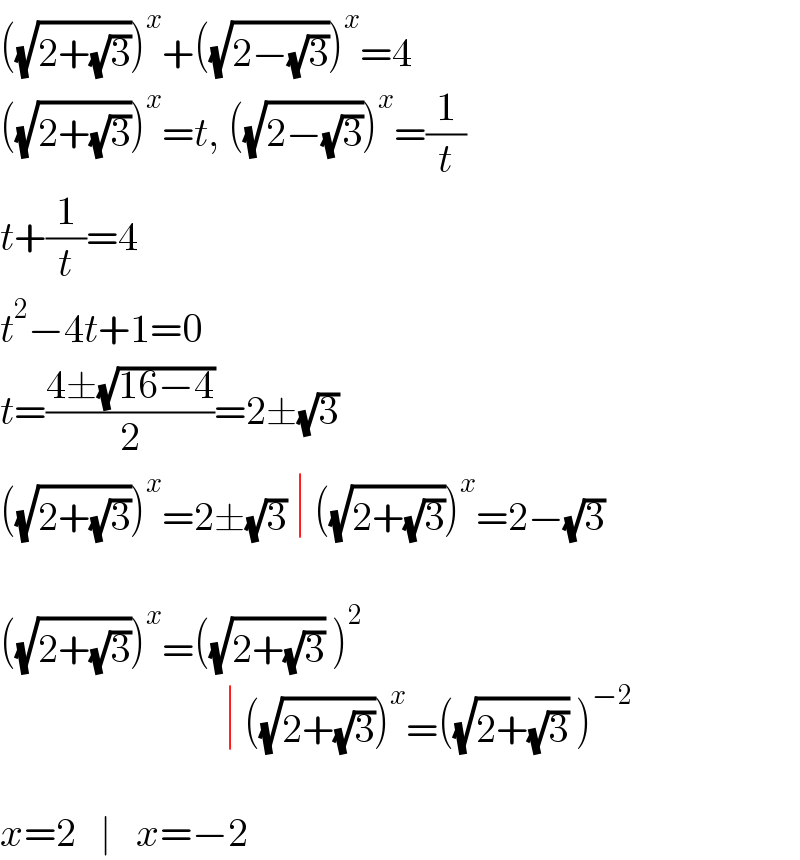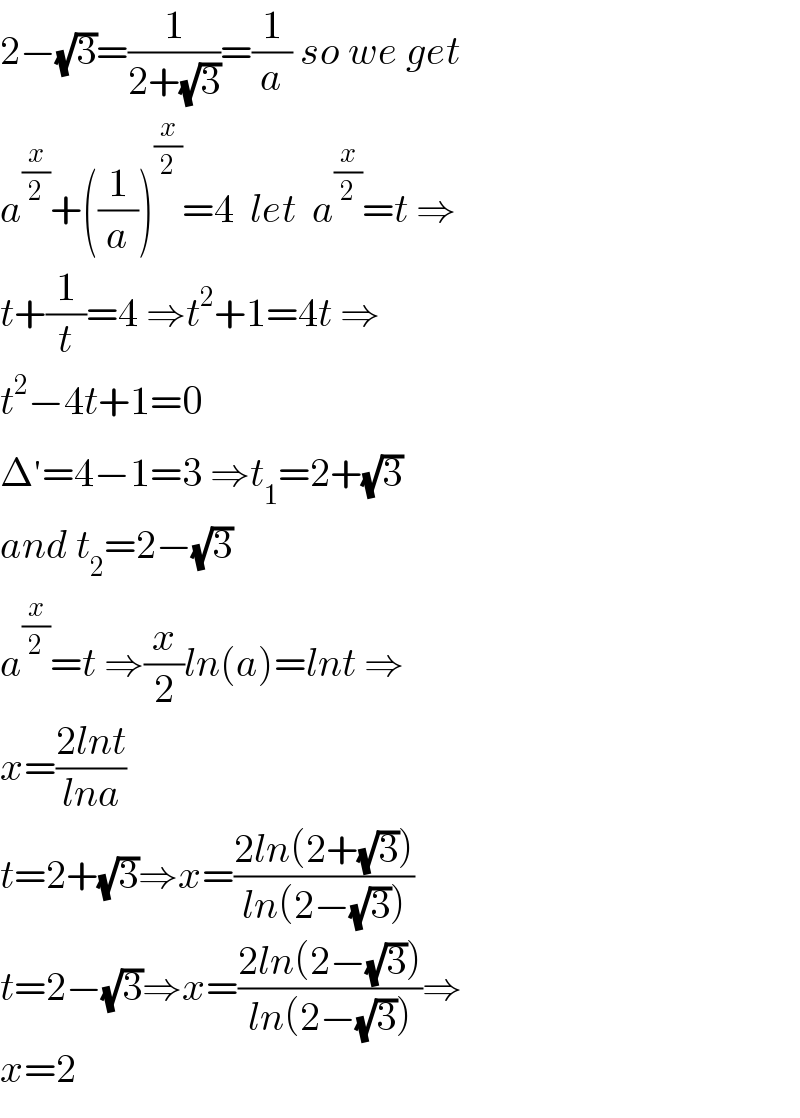Question Number 172509 by Mikenice last updated on 28/Jun/22

Commented by bagjagugum123 last updated on 28/Jun/22

$${x}=\mathrm{2}\:?? \\ $$
Commented by Mikenice last updated on 28/Jun/22

$${pleas}\bar {{e}},{show}\:{the}\:{worki} {gs} \\ $$
Answered by Rasheed.Sindhi last updated on 28/Jun/22

$$\left(\sqrt{\mathrm{2}+\sqrt{\mathrm{3}}}\right)^{{x}} +\left(\sqrt{\mathrm{2}−\sqrt{\mathrm{3}}}\right)^{{x}} =\mathrm{4} \\ $$$$\left(\sqrt{\mathrm{2}+\sqrt{\mathrm{3}}}\right)^{{x}} ={t},\:\left(\sqrt{\mathrm{2}−\sqrt{\mathrm{3}}}\right)^{{x}} =\frac{\mathrm{1}}{{t}} \\ $$$${t}+\frac{\mathrm{1}}{{t}}=\mathrm{4} \\ $$$${t}^{\mathrm{2}} −\mathrm{4}{t}+\mathrm{1}=\mathrm{0} \\ $$$${t}=\frac{\mathrm{4}\pm\sqrt{\mathrm{16}−\mathrm{4}}}{\mathrm{2}}=\mathrm{2}\pm\sqrt{\mathrm{3}} \\ $$$$\left(\sqrt{\mathrm{2}+\sqrt{\mathrm{3}}}\right)^{{x}} =\mathrm{2}\pm\sqrt{\mathrm{3}}\:\mid\:\left(\sqrt{\mathrm{2}+\sqrt{\mathrm{3}}}\right)^{{x}} =\mathrm{2}−\sqrt{\mathrm{3}} \\ $$$$ \\ $$$$\left(\sqrt{\mathrm{2}+\sqrt{\mathrm{3}}}\right)^{{x}} =\left(\sqrt{\mathrm{2}+\sqrt{\mathrm{3}}}\:\right)^{\mathrm{2}} \: \\ $$$$\:\:\:\:\:\:\:\:\:\:\:\:\:\:\:\:\:\:\:\:\:\:\:\:\:\:\:\:\mid\:\left(\sqrt{\mathrm{2}+\sqrt{\mathrm{3}}}\right)^{{x}} =\left(\sqrt{\mathrm{2}+\sqrt{\mathrm{3}}}\:\right)^{−\mathrm{2}} \\ $$$$ \\ $$$${x}=\mathrm{2}\:\:\:\mid\:\:\:{x}=−\mathrm{2} \\ $$
Answered by Mathspace last updated on 28/Jun/22

$$\mathrm{2}−\sqrt{\mathrm{3}}=\frac{\mathrm{1}}{\mathrm{2}+\sqrt{\mathrm{3}}}=\frac{\mathrm{1}}{{a}}\:{so}\:{we}\:{get} \\ $$$${a}^{\frac{{x}}{\mathrm{2}}} +\left(\frac{\mathrm{1}}{{a}}\right)^{\frac{{x}}{\mathrm{2}}} =\mathrm{4}\:\:{let}\:\:{a}^{\frac{{x}}{\mathrm{2}}} ={t}\:\Rightarrow \\ $$$${t}+\frac{\mathrm{1}}{{t}}=\mathrm{4}\:\Rightarrow{t}^{\mathrm{2}} +\mathrm{1}=\mathrm{4}{t}\:\Rightarrow \\ $$$${t}^{\mathrm{2}} −\mathrm{4}{t}+\mathrm{1}=\mathrm{0} \\ $$$$\Delta^{'} =\mathrm{4}−\mathrm{1}=\mathrm{3}\:\Rightarrow{t}_{\mathrm{1}} =\mathrm{2}+\sqrt{\mathrm{3}} \\ $$$${and}\:{t}_{\mathrm{2}} =\mathrm{2}−\sqrt{\mathrm{3}} \\ $$$${a}^{\frac{{x}}{\mathrm{2}}} ={t}\:\Rightarrow\frac{{x}}{\mathrm{2}}{ln}\left({a}\right)={lnt}\:\Rightarrow \\ $$$${x}=\frac{\mathrm{2}{lnt}}{{lna}} \\ $$$${t}=\mathrm{2}+\sqrt{\mathrm{3}}\Rightarrow{x}=\frac{\mathrm{2}{ln}\left(\mathrm{2}+\sqrt{\mathrm{3}}\right)}{{ln}\left(\mathrm{2}−\sqrt{\mathrm{3}}\right)} \\ $$$${t}=\mathrm{2}−\sqrt{\mathrm{3}}\Rightarrow{x}=\frac{\mathrm{2}{ln}\left(\mathrm{2}−\sqrt{\mathrm{3}}\right)}{{ln}\left(\mathrm{2}−\sqrt{\mathrm{3}}\right)}\Rightarrow \\ $$$${x}=\mathrm{2} \\ $$
